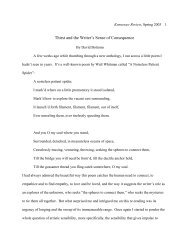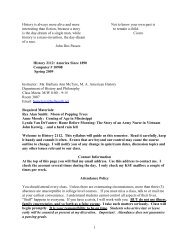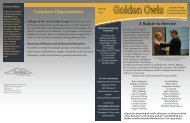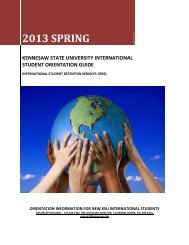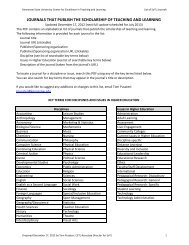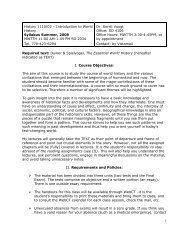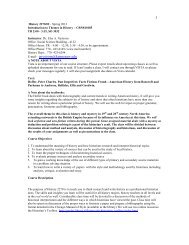Safe and Sound Online - Kennesaw State University
Safe and Sound Online - Kennesaw State University
Safe and Sound Online - Kennesaw State University
You also want an ePaper? Increase the reach of your titles
YUMPU automatically turns print PDFs into web optimized ePapers that Google loves.
When this occurs:<br />
1. Remain CALM.<br />
2. Faculty should encourage students <strong>and</strong><br />
others not to leave or go outside.<br />
3. If you are in dorm rooms, remain there.<br />
4. Select a small interior room with as few<br />
windows as possible or no windows.<br />
5. Close <strong>and</strong> lock all windows, exterior doors<br />
<strong>and</strong> any other openings that lead to the<br />
outside.<br />
6. Stay away from all windows <strong>and</strong> doors.<br />
7. Plant Operations personnel or trained crisis<br />
coordinators should shut down all building<br />
ventilation fans <strong>and</strong> air conditioners, when<br />
<strong>and</strong> if appropriate.<br />
8. If you are told there is a danger of<br />
explosion, close the window shades, blinds<br />
or curtains.<br />
9. Select interior room(s) above the ground<br />
floor, with the fewest windows or air vents.<br />
10. Room(s) should have adequate space<br />
for everyone to be able to sit down<br />
comfortably.<br />
11. Avoid overcrowding by selecting several<br />
rooms when necessary.<br />
For severe weather <strong>and</strong> civil unrest:<br />
1. Stay inside <strong>and</strong> move away from windows.<br />
2. Close <strong>and</strong> lock all exterior doors <strong>and</strong><br />
offices.<br />
3. For extreme weather, relocate to lower<br />
levels in the building<br />
For external chemical, biological or<br />
radiological incidents:<br />
1. Stay inside <strong>and</strong> move to an inner corridor<br />
or office.<br />
2. Plant Operations personnel or trained crisis<br />
coordinators may shut down all building<br />
ventilation fans <strong>and</strong> air conditioners, when<br />
necessary <strong>and</strong> appropriate.<br />
3. Since many chemical agents are heavier<br />
than air <strong>and</strong> tend to hold close to the<br />
ground, move to higher levels of the<br />
building if possible to reduce the transfer<br />
of contaminated air from the outside to the<br />
inside.<br />
4. Remain alert for instructions <strong>and</strong><br />
updates as they become available from<br />
the emergency personnel <strong>and</strong> university<br />
administrators.<br />
How to evacuate:<br />
At the sound of a fire alarm or if you are<br />
instructed to evacuate, leave your work area<br />
immediately, proceed to the nearest exit<br />
<strong>and</strong> leave the building. If you are the first to<br />
recognize a fire situation, activate the alarm,<br />
evacuate to a safe location using the nearest<br />
exit <strong>and</strong> notify Police Emergency at extension<br />
6666 or at 770-423-6666.<br />
1. Remain CALM.<br />
2. Do NOT use elevators, use the stairs.<br />
3. Assist the physically impaired. If he/she<br />
is unable to exit without using an elevator,<br />
secure a safe location near a stairwell,<br />
<strong>and</strong> immediately inform KSU Police or<br />
the responding fire department of the<br />
individual's location.<br />
4. Proceed to a clear area at least 150 feet<br />
away from the building. Keep all walkways<br />
clear for emergency vehicles.<br />
5. Make sure all personnel are out of the<br />
building.<br />
6. Do not re-enter the building.<br />
Muster <strong>and</strong> Head Count<br />
Individuals in leadership positions should<br />
attempt to account for students, faculty, staff<br />
<strong>and</strong> visitors who are under their supervision<br />
at the time of the evacuation. Those positions<br />
may include:<br />
- Faculty or instructors in the classroom<br />
- Crisis coordinators<br />
- Office managers<br />
- Supervisors<br />
Once you have assembled at your designed<br />
meeting place, conduct a reasonable<br />
accounting of personnel. Inform public safety<br />
officials or crisis coordinators if someone is<br />
unaccounted for or if you suspect someone<br />
did not exit the building, <strong>and</strong> inform<br />
them of the missing person’s last known<br />
whereabouts.<br />
NOTIFICATION<br />
TO THE COMMUNITY ABOUT AN<br />
IMMEDIATE THREAT: KSU ALERT<br />
KSU will immediately distribute emergency<br />
notification warnings to the campus<br />
community upon confirmation of a significant<br />
emergency or dangerous situation on campus<br />
involving an immediate threat to the health<br />
or safety of students or staff, unless issuing a<br />
notification will, in the professional judgment<br />
of responsible authorities, compromise efforts<br />
to assist a victim or to contain, respond to or<br />
otherwise mitigate the emergency. Examples<br />
of emergencies that would warrant such a<br />
notification include but are not limited to: an<br />
active shooter on campus, hostage/barricade<br />
situation, a riot, bomb threat, a tornado, a<br />
fire/explosion, suspicious death, structural




